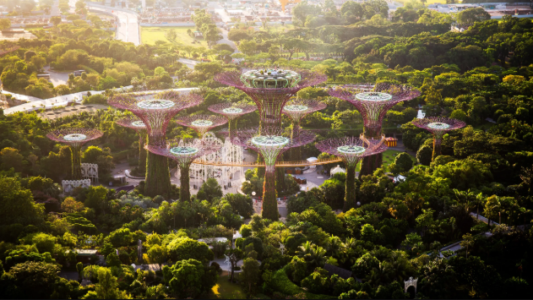Experts explore the role of design and innovation in shaping a sustainable and vibrant tomorrow.
As the spotlight falls on Paola Antonelli at the Victoria Theatre, anticipation buzzes through the audience. This renowned Italian architect, curator, and author is the Curatorial Director for the Design Futures Symposium during Singapore Design Week 2022. With eager attention, attendees listen as she poses a thought-provoking question: “Who has the agency to determine and build the future?”
This inquiry encapsulates the symposium’s focus, urging participants to envision daring solutions to pressing issues like food waste, climate change, and land scarcity. My instinctive response leans towards government and policymaking, yet the symposium suggests a different perspective—design is integral to overcoming Singapore’s challenges.
Held on September 20 at Victoria Theatre, the symposium brought together both local and international designers and thinkers, emphasizing the significance of design in addressing future hurdles. “Think of design as an enzyme for progress,” Paola asserts, a phrase she reiterates to emphasize its importance.
In biology, enzymes act as catalysts, accelerating chemical reactions essential for life. Paola’s analogy highlights that we seek rapid progress, but it must also foster well-being for all.
Typically, when people hear “design,” they envision vibrant colors and quirky furniture rather than a tool for societal advancement. As I sit, trying to process this complex idea amidst the effects of the symposium’s open bar, I realize that I’m not a designer, but technology can help visualize Singapore’s potential future.
With the aid of AI image generator Midjourney, we can imagine what Singapore might look like a century from now, as suggested by the visionary speakers at the Design Futures Symposium 2022.
Food Waste, Fly Away!
Picture visiting your local hawker center for a nasi lemak craving. Transparent glass cases filled with thousands of black soldier fly larvae sit next to the tray return stations. Instead of tossing leftover food into bins, you feed the scraps to these larvae. In 2021, only 19% of Singapore’s food waste was recycled, contributing to carbon emissions and climate issues. These larvae consume food waste and convert it into protein and fertilizer, usable for crops.
The design challenge lies in creating these glass cases: How can they be visually appealing and functional in a hawker center? If this approach is embraced, we might soon share our dining space with these insects—a minor sacrifice for reducing food waste.
A Growing Population on Diminishing Land
Singaporeans frequently grapple with housing shortages, with land scarcity becoming an urgent issue. Home prices have risen by 3.4%, prompting the question: Can we maximize housing without sacrificing quality of life? Architects have shown that it’s theoretically possible to house the world’s population in just 0.5% of the Earth’s land area.
As older estates are redeveloped, the future of public housing may involve constructing taller buildings, inspired by models like Pinnacle@Duxton. Imagining how to house Singapore’s entire population within a fraction of the land area is a daunting yet necessary endeavor.
The Future of Play: Moving into the Metaverse
In a land-scarce environment, Singaporeans often tire of physical spaces. While there are familiar options like Clarke Quay and Universal Studios, the metaverse presents an innovative solution. This digital realm could expand recreational opportunities, allowing users to socialize in limitless spaces, even if it can’t entirely replace the need for tangible facilities.
From Fever Dream to Reality
The futuristic visions created by AI at the symposium are rooted in human ingenuity. The intriguing scenarios stem from the exploration of ideas presented by the speakers.
As attendees leave the Victoria Theatre, the refrain of “design as an enzyme for progress” resonates. Design is not just for the aesthetically inclined; it’s a universal human practice. If this is true, then the future belongs to all of us, waiting to be shaped by our collective creativity and collaboration.








